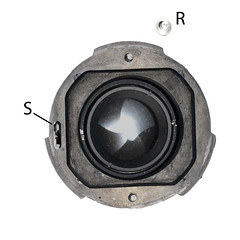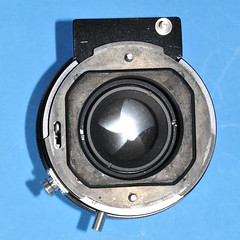Difference between revisions of "Bayonet"
(started a new resource page) |
(Added a tiny bit about filters etc, just to establish that these bayonets also need to be covered, either here or on their own page.) |
||
| (One intermediate revision by one other user not shown) | |||
| Line 1: | Line 1: | ||
| − | {{WIP | + | {{WIP}} |
| − | + | A '''bayonet''' coupling is a way of attaching a lens, or a lens accessory such as a filter or hood, typically by a push-and-twist action. It has the advantage of being faster to mount or demount than a screw-thread, and it automatically puts the lens or accessory in a certain alignment once mounted. | |
| + | ==Bayonet lens-mounts== | ||
One of the problems many users and collectors may encounter, is to positively identify a bayonet mount of an isolated lens they are looking at. This comes into play especially with the third party lenses. | One of the problems many users and collectors may encounter, is to positively identify a bayonet mount of an isolated lens they are looking at. This comes into play especially with the third party lenses. | ||
| Line 17: | Line 18: | ||
<td valign="top" width="200"><b>[[Konica | KONICA]]</b><br><br> | <td valign="top" width="200"><b>[[Konica | KONICA]]</b><br><br> | ||
[[Koni-Omega]] mount designed by [[Konica]] and then continued by [[Mamiya]] when they took over production of the [[Koni-Omega|Rapid Omega]] models.</td> | [[Koni-Omega]] mount designed by [[Konica]] and then continued by [[Mamiya]] when they took over production of the [[Koni-Omega|Rapid Omega]] models.</td> | ||
| − | <td valign="top" width="240">Three-lobed bayonet with shutter release set internally at the | + | <td valign="top" width="240">Three-lobed bayonet with shutter release set internally at the 9 o'clock position (S). Small lens board with rangefinder coupling pin (R). <br>Bayonet diameter: XYZ mm</td> |
<td valign="top">{{Flickr image | <td valign="top">{{Flickr image | ||
| image_source= http://www.flickr.com/photos/heritagefutures/4753838202 | | image_source= http://www.flickr.com/photos/heritagefutures/4753838202 | ||
| Line 37: | Line 38: | ||
</tr> | </tr> | ||
</table> | </table> | ||
| + | |||
| + | |||
| + | ==Bayonet hood and filter mounts== | ||
| + | * Franke & Heidecke adopted [[Rollei bayonets|three bayonet mounts]] for the various lenses offered with the [[Rolleiflex]] cameras. These serve hoods, filters and close-up lens pairs. Some other makers of TLR cameras have adopted the Rollei bayonets, particularly the Bay I fitting. | ||
| + | *Some [[Hasselblad]] lenses use bayonet filter mounts. | ||
Latest revision as of 14:32, 7 December 2015
This is a work in progress.
A bayonet coupling is a way of attaching a lens, or a lens accessory such as a filter or hood, typically by a push-and-twist action. It has the advantage of being faster to mount or demount than a screw-thread, and it automatically puts the lens or accessory in a certain alignment once mounted.
Bayonet lens-mounts
One of the problems many users and collectors may encounter, is to positively identify a bayonet mount of an isolated lens they are looking at. This comes into play especially with the third party lenses.
| Manufacturer and Mount Type | Descriptive text | Annotated Photo | Unmodified photo |
| KONICA Koni-Omega mount designed by Konica and then continued by Mamiya when they took over production of the Rapid Omega models. |
Three-lobed bayonet with shutter release set internally at the 9 o'clock position (S). Small lens board with rangefinder coupling pin (R). Bayonet diameter: XYZ mm |
|
|
Bayonet hood and filter mounts
- Franke & Heidecke adopted three bayonet mounts for the various lenses offered with the Rolleiflex cameras. These serve hoods, filters and close-up lens pairs. Some other makers of TLR cameras have adopted the Rollei bayonets, particularly the Bay I fitting.
- Some Hasselblad lenses use bayonet filter mounts.

